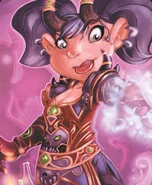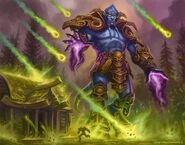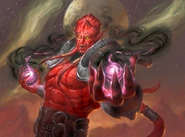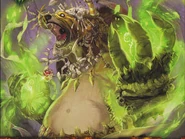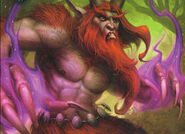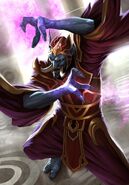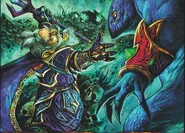The highly destructive fel magic is the magic of disorder. It is stated to be a brutal and extremely addictive energy fueled by drawing life from living beings. However, energy cannot be broken down or created and life energies are not some created resources to serve as fuel for energy. Fel energy is not some void that is devoid of energy and needs to absorb energy in order to function, move, or operate. If anything, fel magic is a spiritual magic that life force (or Spirit) is transformed into with the Life Tap ability. Spirit is a life-giving force that binds all things in existence as one, sacrificing its life. Sacrificial magic was considered the greatest violation of life and thetitans (living worlds) had hounds, instantly attuned to punish those who delved into such sorcery, police the use of arcane magic - the magic of order.
Together, the forces of disorder and order govern the cosmic systems of the physical universe. As the force of disorder, the highly destructive fel magic would (or does) affect systems. Indeed, concentrated fel energy can (or does) cause a system to go haywire.
An Intro To Fel magic[]
From the moment the cosmos came to be, dark spirits within the Void sought to twist reality into a realm of eternal torment. These entities were known as the void lords and they pooled their power, hurling dark creatures throughout the physical universe. In time, these wicked beings would come to be known as Old Gods.[1] These physical manifestations of the Void that exist only to transform the worlds they infest into places of despair and death.[2] Deep within the fiery core of worlds that some Old Gods can infest, spirits known as world-souls were formed. These spirits are the spirits of the titans,[3] godlike beings composed of the primordial matter from which the universe was born.[4] They are essentially worlds and in an isolated corner of the Great Dark, a miraculous world was taking shape. Deep within this world's core, the spirit of a titan stirred to life and one day, it would be known as Azeroth.
Eventually, a group of Old Gods plummeted down from the Great Dark and slammed into Azeroth's surface, embedding themselves in different locations across the world. As creations of the void lords, these Old Gods sought to corrupt Azeroth's world-soul. Now, some claim a dream born from Azeroth's slumbering world-soul is the Emerald Dream.[5] In truth, the Emerald Dream was forged by incredible beings known as the keepers to act as a map for the evolutionary path of Azeroth's flora and fauna.[6] Unfortunately to some, the evolutionary path of worlds can succumb to disorder.[7]
An Emerald Nightmare and Demons[]
One of the Old Gods, Yogg-Saron, used trees as a doorway into the Dream — a doorway through which the other Old Gods could grasp the ethereal domain as well. Small seeds of corruption were planted throughout the realm and, in time, these seeds polluted the dreamways. This marked the beginning of what would become known as the Emerald Nightmare.[8] One place where the Nightmare held firmly is known as the Rift of Aln, which is believed bled into the Great Dark Beyond and the Twisting Nether, an astral dimension that the most unstable energies coalesced into.[9] The creatures that had emerged from this turbulent realm were known as demons.
Demons had been formed as a result of the Light and Void energies that had bled together at the borders of the Twisting Nether. With time, these bloodthirsty demons clawed their way into the physical universe, terrorizing mortal civilizations and bringing ruin to world after world. The titans feared that the demons would disturb the quest to find find and awaken other world-souls.[10] Eventually, two titans went to war with the troublesome demons. Their names were Sargeras and Aggramar. While hunting demons by himself, Sargeras discovered the void lords' plans to corrupt a slumbering world-soul. Sargeras knew that stopping them was impossible and he came to a troubling conclusion. Existence itself was flawed. The only way to spare the universe from the void lords was by burning away all creation and he would cleanse the universe in fire to thwart the void lords' plans. And he would not stop this quest — this Burning Crusade — until every star had gone dark and he stood over a universe of embers. Despite Sargeras' vast power though, he could not prosecute his Burning Crusade alone. He needed loyal servants, ones that would embrace their role as agents of destruction. He needed the very things he had sworn to destroy. He needed demons.[11]
The Burning Crusaders[]
Sargeras rallied the wicked creatures to his side, and he indulged in the terrible might of fel magic. The destructive energy enveloped his soul and scarred his noble form forever, but it also granted Sargeras power beyond anything he had ever known. The corrupted titan gave some of this newfound power to his demonic acolytes, uniting them as one in the emerald fires of fel magic. He named his growing army the Burning Legion, and he unleashed it upon the unsuspecting universe.[12] Sargeras's former apprentice, Aggramar, hunted down this vast demonic army only to find that it was led by his beloved mentor. Aggramar demanded an explanation from the titan but received none. Sargeras would not abandon his Burning Crusade to extinguish all life in the cosmos. Not for Aggramar. Not for anyone. The mentor and his protege came to blows but Aggramar was no match for Sargeras's fel power and retreated from the battle, gathering the rest of the Pantheon to stop their fallen brother. Despite their earlier confrontation with Sargeras, Aggramar clung to the stubborn belief that he could bring his friend back to the side of good. He tried to reason with Sargeras one last time and tried to awaken whatever nobility still remained in his mentor's soul. In response, Sargeras annihilated Aggramar. The stunned members of the Pantheon made war on Sargeras but, in the end, Sargeras prevailed. He engulfed his kin a storm of fel fire and shattered their physical forms.[13]
The Eredar Warlocks[]
The First Summoners Of Fel Energies On Azeroth And The First Demon Hunters[]
God of Fel and Flame[]
| “ | "There is only one god ... and his name is Sargeras."
- Xavius
|
” |
Sargeras, dark god of chaotic magic,[14] is the God of Fel and Flame.[15] Once a noble warrior for order and peace, Sargeras came to believe there was a fundamental flaw in the universe, a flaw that made his primary purpose an impossible goal. He decided the other titans were deeply misguided in trying to establish order throughout creation. Under the circumstances, the struggle was futile. The universe had to be destroyed utterly and remade without the underlying defect. Only then could true order be achieved. Thus, Sargeras conceived of a sweeping campaign to bring about the end of all things: the Burning Crusade. To carry out his plan, he created the Legion, whose ranks he bolstered by creating demons: immortal creatures whose hunger, power, and malice made them perfect killing machines.
Organizations[]
Empyrean Society[]
Royal Apothecary Society[]
Professions of the cosmos[]
Demon Hunters[]
Demon hunters, disciples of Illidan Stormrage, uphold a dark legacy, one that frightens allies and enemies alike. The Illidari embrace fel and chaotic magics — energies that have long threatened the world of Azeroth — believing them necessary to challenge the Burning Legion. Wielding the powers of demons they've slain, they develop demonic features that incite revulsion and dread in fellow elves.[16]
Mages[]
Of the arcane, mages are diviners of secrets, balancing the ebb and flow of incredible mystic energies. Unparalleled skill is required to manipulate the volatile forces of the universe. These practitioners push their magical knowledge to its very limits—often to the brink of their own exhaustion, and at great risk to the world around them. Those who master this craft are capable of releasing a barrage of unrelenting power upon their enemies, drawing upon replenishing energies to maintain their assault for as long as the battle demands.[17]
It is stated that it is unimaginable that any mage would study fel magic,[18] but it seems as if mages can — and/or do — study fel magic.
Shaman[]
Shaman can be defined as fel,[19] spiritual guides and practitioners, not of the divine, but of the very elements. Unlike some other mystics, shaman commune with forces that are not strictly benevolent. The elements are chaotic, and left to their own devices, they rage against one another in unending primal fury. It is the call of the shaman to bring balance to this chaos.[20]
Warlocks[]
| “ | Chaotic magic always has the potential for unexpected results.
|
” |
Warlocks are magical practitioners of who seek to understand darker, fel-based magics, including destructive spells.[21] According to Justin Parker, warlocks aren't necromancers even though they have necromantic abilities. It seems Justin Parker doesn't understand that warlocks can't have the abilities of necromancers without being necromancers. Perhaps a warlock is a necrolyte, which might not be a necromancer even though necrolytes were referred to as necromancers? (necrolyte is definitely spelled differently from necromancer). Necrolytes are binders of souls who command the black powers that hold control over the earth, which can be defined as the world. The living worlds are what the titans awoke as and they were uniquely susceptible (and connected) to fel magic. Presumably, this connection fel magic had with worlds allowed its users to manipulate a world and the spirits of the living and the dead residing within it. And through ceremonies, necrolytes learn to warp the essence of shadow to use for their advantage.[22]
Affliction warlocks are the masters of shadow magic, indulging in fel energies that wither away their life force over time.[23] Warlocks can be considered the masters of shadow-touched powers, but unlike shadow priests—deadliest when pushed to the brink of insanity—the warlocks delight in using fel forces to cause intense pain and suffering in others. They revel in corrupting minds and agonizing souls, leaving enemies in a state of torment that would see them undone in due time. Even the most battle-hardened warriors can be deceived, landing blow after blow against the warlock, only to succumb to their suffering as their very vitality is siphoned away by the dark spellcaster.[24]
The denizens of the cosmos[]
Dark Naaru[]
The dark naaru are creatures of living holy energy and, presumably, shadow energy. It is EXCEEDINGLY rare for a naaru to fall into a void state, and even rarer for a fallen naaru to be brought back into the Light. A naaru's fall into the void represents a catastrophic loss for the naaru and for the forces of the Light, and it is the saddest, most heart-wrenching event for the naaru to witness. Conversely, a naaru being reborn into the Light brings renewed hope and sense of purpose to every naaru.[25]
Because dark naaru have both Light and Void energies, it could be possible that the Light and Void energies of a dark naaru can become unstable and coalesce into nether or bleed together at the borders of nether, forming demons and their fel energies.
Demons[]
Willing or otherwise, all creatures who use the power of fel magic slowly take on the appearance of demons. Demons are evil immortals who feed upon life and magic. In order to become a demon, a creature must be infused with fel energy, the dark and corrupting essence wielded by the Burning Legion itself.[26] The fallen titan Sargeras created this vast demonic army to scour all creation. The Burning Legion moves from world to world, decimating everything in its path with devastating fel magic.[27]
Eredar[]
The eredar are one of the oldest known races in the universe. Sargeras infused the eredar with fel energies, twisting their forms to resemble hideous demons, and found quick use for his new fel-corrupted converts. The eredar settled in as commanders within the Burning Legion. Under the eredar's leadership, the ranks of the Burning Legion swelled with new demonic races, gathered from the Twisting Nether and the world of the Great Dark.[28]
The eredar who rejected Sargeras's offer became known as draenei. Some of them had been affected by fel energies. These draenei mutated into lesser forms, resulting in a series of subspecies. The Broken and the Lost Ones are two such genetic offshoots. Their warped bodies bear only a rough resemblance to the proud draenei they once were, and quite a few lost their grip on sanity.[citation needed]
Furbolgs[]
Furbolgs are hulking, simple-minded bear-men who live within the savage corners of Ashenvale forest. Though they have no special love for war or murder, their tribes have become increasingly hostile of late. There is a camp of Deadwood furbolgs in a place called Felwood. The Deadwood tribe is evil, but it is the effects of the fel that pollutes their minds. Their hostility is not truly an innate quality, yet they cannot be helped.[29]
Orcs[]
Orcs are beings that are rugged by nature. Initially, they lived as shamanic clans on the lush world of Draenor. They abandoned their peaceful culture when Kil’jaeden, a demon lord of the Burning Legion, corrupted the orcs and used them in his vengeful plot against the draenei, who were exiles from Kil’jaeden’s homeworld. Kil’jaeden’s plan worked. The orcs drank the blood of Mannoroth—a prominent Burning Legion general—infusing them with power and enslaving them to the Legion. Exposure to fel energies turned their naturally brown skin into a sickly green. Under the demon’s influence, the orcs killed off most of the draenei population, but Kil’jaeden would not stop there.[30]
Fel orcs are members of the orcish race who have been completely consumed by madness and bloodlust. Engineered by the Burning Legion, fel orcs are created by the continual consumption of pit lord blood. This results in a blood haze, uncontrollable bloodlust, and physical changes as well—bright red skin, sharp spines, and reddened eyes signify a fel orc as much as its maddened lust for destruction.[31]
Satyrs[]
The satyrs have been able to corrupt anything they come in contact with, which includes the ancients that made Felwood their home. By the use of the fel, the spirit of the ancient has been bound and tortured, never completely released.
Sin'dorei[]
Blood elves are high elves who had turned to absorbing demonic magic after the loss of their vaunted power source, the Sunwell, and subsequently become addicted to the fel energies.[32] They took the ways of demons to fight demons — indeed, actually draining the magic from demons like leeches.[33]
Felblood elf, aka Fel elf: blood elves loyal to Kael'thas Sunstrider who have been granted demonic power.
Sludge beasts[]
An entropic ooze is a foul slime that began to crawl the earth where the tree Vordrassil touched the ground.[34] Vordrassil was once known as Andrissal, a tree with roots that had touched the prison of Yogg-Saron. The Old God had infused the tree with its foul energies, and thus all living creatures in the area were slowly being driven to madness. Andrissal was vulnerable to corruption and there was no way to spare the World Tree or ease its suffering. The only recourse, it was decided, was to destroy Andrissal.[35]
Titans[]
Composed of the primordial matter from which the universe was born, the titans are godlike beings[27] that were uniquely susceptible (and therefore connected) to fel magic.
Void revenants[]
Void revenants, remnants of a species overtaken by Void, are a race of parasitic void-beings that tear holes through the planes of reality, consuming and absorbing the energies and beings within. They can be fed overwhelming fel energies.[36]
Wild Gods[]
The Wild Gods are primal manifestations of life and nature.[37] A number of Wild Gods can succumb to the poisoned black blades and fel powers wielded by the demons.[38]
The speculation section[]
Are Constructs The Source Of Fel Magic?[]
According to Sean Copeland the nature of fel magic is created from destroying something else. If fel magic comes from destruction, it does not come from the living because destruction is a process. Despite that fact, Sean told someone to "think burn life to create kind of thing".[39]
Are Demons The Source Of Fel Magic?[]
According to Sean Copeland, demons contain fel magic but aren't the source, stating that the nature of this magic is created from destroying something else.[39]
Can A Warlock Exist Without A Fel Demon?[]
Demonic power is a nether-touched power that exists in - and is ultimately derived from - the Twisting Nether because demons are from the Twisting Nether. Despite that fact, after he was asked if perhaps warlocks are harnessing their power from the Twisting Nether, Sean Copeland - Blizzard's very own Lore Historian - stated, “No, that’d be magi, IIRC. They gain power by the destruction of another source (recall the undead warlock in original cinematic)"[40] Additionally, he claims that demons contain fel magic but aren't the source, stating that the nature of this magic is created from destroying something else.[39][41] So not only is he denying that demons are the source of the demonic fel magic, he is denying that warlocks harness their power from the place demons and demonic powers are from. Ultimately, this person is claiming that a demonologist can exist without a demon and why is that? Could it be because warlocks are essentially necromancers (magi who have dabbled in dark magic) if their power is from the Twisting Nether?
Is Fel From A realm of Chaos?[]
"While nearly all of the Orcish Hordes believed that our dead elders watched and guided us from the depths of some lost realm of chaos, I believed this notion to be a product of ritual and not reality. Within the Twisting Nether I discovered that the spirits of the dead do linger on, floating on the astral winds between the worlds." - the warlock Gul'dan[42]
Fel is the primal force of chaos[43] and the force of chaos would be from a place of chaos, which the Twisting Nether is.[44] If fel is from the Twisting Nether, perhaps the study of fel magic is necromancy because the Twisting Nether, according to the Warcraft II manual, is the realm of the dead where the spirits of the dead linger. It's important to note that although the Twisting Nether is the realm of the dead according to the Warcraft II manual, Blizzard produced a book that established that the Shadowlands is the place where many believe mortal souls are drawn into during the point of death. By channeling the necromantic powers of the underworld, or the Twisting Nether, one can create a field of dark energy that drains life-force. Even though it drains life, fel is not the same as death according to Micky Neilson—veteran of Blizzard Entertainment.[45]
Is Fel Magic A Form Of Life Magic Or Necromantic magic?[]
According to Sean Copeland, fel is entropic as in destroys life to fuel the caster's spells.[46] Life—something described as eternal—[47] is a construct if it can be destroyed because destruction, as stated before, is the process of destroying structures, breaking them down into the parts that they’re constructed of. Constructs are not living things and so how can animate beings be alive if the thing that animates them is not a living thing? It is stated that only life could give life[48] and if the thing that animates an animate being isn’t a living thing and therefore has no life, the study of magic involving an animate being can definitely be considered necromancy: One thing to consider is the fact that necromancy can be viewed as animancy (or a form of it) and that studying magic used to animate inanimate objects is studying magic one can use to animate the dead.
After Micky Neilson was asked if life can be destroyed, he stated that it seems like just a change of energy and in most – if not all – fantasy settings, death (or necromantic) magic is considered to be a form of life magic (it’s a form of magic and it’s the opposite of life magic). Presumably, this is because if life can be converted (or transformed) into another state, the state that life can be converted (or transformed) into would not be animate or living. And when regarding to World of Warcraft lore, warlocks (according to how Dave Kosak describes it) convert life into fel, draining the victim as a source of power.[49] Fel is the primal force of chaos and can pool into a green goop when it’s in physical form.[43] It is described as a substance[50] and it can be animated[51] (is that substance alive when animated?). Prior to being animated, fel is inanimate and so warlocks can, presumably, animate—or fuel—the fel by drawing life from living beings and be considered animancers or necromancers.
Is Fel Magic A Manifestation Of The Void?[]
Disorder can be defined as a lack of order and it is manifested as fel magic.[52] As such, one can consider fel magic to be a manifestation of a void, which can be defined as a lack. The void is chaotic since energies, naturally, want to spread out and become messy. Despite that fact, the writer Matt Burns stated that he thinks there are some exceptions to that rule when it comes to Warcraft powers.[53] It seems that Matt Burns doesn't understand that his thoughts cannot change the fact that the void is devoid of order (disorder), which is manifested as highly destructive fel magic - an energy that is fueled by drawing life from living beings.[52]
Is Fel Magic Actually Shadowflame?[]
"See how the shadowflame animates the bones? They fight at my command!" - Nefarian[54]
According to Dave Kosak, shadowflame is likely fel magic infused with shadow.[55] However, it seems that shadowflame is actually a combination of shadow (void) and fire - a combination that doesn't seem possible to create. Void is described as dark[56] and cold[57] whereas fire is defined as light and heat. It seems that the void cannot be combined with light and heat because it would just suck the light and heat into non-existence. As such, fel magic—or fel flame—itself seems to be shadowfire: The fel flame spell emits a wave of shadowfire.[58]
Is Fel The Force Of Order?[]
Fel, as stated before, is the force of chaos,[43] which is order unrecognized by a lesser mind according to the arcane user Iyyokuk the Lucid. It is stated that order is most commonly perceived as arcane magic in reality but that does not mean it's always perceived as arcane magic. This type of energy is innately volatile, and wielding it requires intense precision and concentration. Conversely, disorder is manifested as highly destructive fel magic.[52] As the manifestation of disorder, fel magic cannot really exist without order because without order, there is no disorder. As such, perhaps fel magic is a form of arcane magic. If that's the case, the study of fel magic might be necromancy, which is described as a school of arcane magic by a book located at Dalaran.[59]
The RPG[]
Lua error in package.lua at line 80: module 'Module:Inlinegfx/img_link_data.json' not found.
The ultimate manifestation of the demonic arcane on Azeroth is fel (aka fel energy or fel magic). This energy, which most commonly manifests itself as ghastly, green-yellow flame, is arcane magic at its most corrupt, for it employs the blood of demons. Unlike arcane magic, the use of fel magic corrupts the user’s body and soul. By contrast, the chief danger of arcane magic is that using it inevitably leads to the desire to wield greater power: power that only fel magic can provide.[60] (DF 37)
Since the Burning Legion returned to Azeroth, the world's heroes have encountered fel weapons and fel magic at an increasing frequency. As demon cults continue to fester and grow in Desolace, Ashenavle, and other remote corners, gruesome sacrifices are held to entice demons into giving their blood in trade. The cultists use their blood to enchant the weapons they hope will bring about their masters' ultimate victory.[61] (M&M 24)
Fel poison[]
Fel-poisoned creatures are another threat, appearing in places where the Burning Legion is strongest. Not even dragons are immune to the corruption of fel magic.[62] When a creature with a natural poison attack is imbued with fel energy, its venom becomes more difficult to resist.[61] (M&M 24)
Fel spells[]
Spells with the fel descriptor are very difficult to resist. Some arcanists can cast fel spells, perhaps after drinking demon blood. Casting a fel spell is described by many spellcasters as a euphoric experience. If arcane magic is an addiction, fel magic is the embodiment of the drug in its purest form.
Demons sometimes tempt spellcasters by offering small amounts of their blood in exchange for services. If the recipient drinks the demon's blood within 24 hours of the offering, the next arcane spell they cast will be a fel spell. Fel blood is highly addictive as well as corrupting. Anyone who drinks it has a chance of becoming dependent on fel blood, and unless the person continues to drink it daily, they will suffer withdrawal symptoms. They have a chance of breaking the addiction seven days after first drinking the fel blood.[61] (M&M 24)
Fel weapons[]
"The Burning Legion has no need for ammunition like cannonballs. The demons utilize far more potent weaponry." - Dralor[63]
When the demons brought death and damnation to Azeroth, they also carried their own brand of magic to the world. Their blood had magical properties; it addicted arcane magic users and could be used to create evil weapons. When a weapon is forged in demon blood, it becomes a fel weapon. It glows with a foul, yellow-green fire and deals extra damage to good-aligned opponents.[64] (WoWRPG 252)
Trivia[]

The defeat of Kael'thas Sunstrider
- Grand Warlock Nethekurse augmented his power with a pair of mystical braziers containing fel embers. The Fel Ember emitted faint purple sparks, but no heat.
- Dissatisfied with the limits of arcane magic, prince Kael'thas began consuming fel energy to acquire even greater power. In order to become a demon, a creature must be infused with fel energy, and according to the Dungeon Journal description for Kael'thas' encounter in Magister's Terrace, his veins burned with limitless fel magic.[65] Kael'thas most likely became a demon that somehow retained the form of an elf. If this is the case, Kael'thas was sent to the Twisting Nether upon his defeat, the place where demonic souls are sent and the only place they truly die.[66]
- In Hebrew, the word "אפל" (Afel) means "dark" or "tainted". The English adjective "fell" means "cruel" or "savage"[1]. The word "fel" can also mean "bile", and according to The American Heritage® Dictionary of the English Language: Fourth Edition (2000), it is related to a number of words of Indo-European origin: yellow, gold, gall, cholera, and felon, to mention a few. The same source indicates that the Indo-European root from which it is derived, ghel, meant "to shine". It may also find it's origin in the Old-English word "fūl" which means "foul" and is the origin of the word "defile". Fel also is a Swedish word for "Wrong" or "Incorrect", it is however pronounced differently (the E is pronounced as the first E of "Error" which make the word sound like "fEl").
Media[]
Videos[]
References[]
- ^ World of Warcraft: Chronicle Volume 1 pg. 51-52 on iBooks
- ^ World of Warcraft: Chronicle Volume 1 pg. 36-37 on iBooks
- ^ World of Warcraft: Chronicle Volume 1 pg. 44 on iBooks
- ^ World of Warcraft: Chronicle Volume 1 pg. 34-35 on iBooks
- ^ World of Warcraft: Chronicle Volume 1 pg. 106 on iBooks
- ^ World of Warcraft: Chronicle Volume 1 pg. 29-30 on iBooks
- ^ World of Warcraft: Chronicle Volume 1 pg. 48 on iBooks.
- ^ World of Warcraft: Chronicle Volume 1
- ^ World of Warcraft: Chronicle Volume 1 pg. 42-43 on iBooks
- ^ World of Warcraft: Chronicle Volume 1 pg. 53-55 on iBooks
- ^ World of Warcraft: Chronicle Volume 2 pg. 19-23 on iBooks
- ^ World of Warcraft: Chronicle Volume 2 pg. 23 on iBooks
- ^ World of Warcraft: Chronicle Volume 2 pg. 47-49 on iBooks
- ^ The Last Guardian
- ^ Ultimate Visual Guide, pg ?
- ^ Blizzard Entertainment. Game Guide > Classes > Demon Hunter. World of Warcraft official game site (US). Retrieved on 2015-11-23.
Blizzard Entertainment. Game Guide > Classes > Demon Hunter. World of Warcraft official game site (EU). Retrieved on 2015-11-23. - ^ World of Warcraft > Legion Class Preview Series: Mage
- ^ Quest:The Next Level Has Arrived
- ^ Wowhead: Database > Items > Armor > Mail > Head: Helm of the Fel Shaman
- ^ World of Warcraft > Game Guide > Classes > Shaman
- ^ Ultimate Visual Guide pg. 21
- ^ Warcraft: Orcs & Humans manual - Necrolyte
- ^ World of Warcraft > Legion: Warlock Artifact Reveal
- ^ Blizzard Entertainment 2015-11-10. Legion Class Preview Series: Warlock. World of Warcraft official game site (US).
Blizzard Entertainment 2015-11-10. Legion Class Preview Series: Warlock. World of Warcraft official game site (EU). - ^ Ask CDev - Naaru void state
- ^ World of Warcraft > Game Guide > Races > Blood Elf
- ^ a b World of Warcraft: Chronicle Volume 1 pg. 25 on iBooks
- ^ World of Warcraft: Chronicle Volume 1, pg. 103-104 on iBooks
- ^ Quest:Deadwood of the North
- ^ World of Warcraft > Game Guide > Races > Orc
- ^ Ultimate Visual Guide pg. 39
- ^ Stormrage, pg. 292
- ^ Night of the Dragon, pg. 239
- ^ Quest:The Failed World Tree
- ^ World of Warcraft: Chronicle Volume 1, pg. 260 on iBooks
- ^ http://us.battle.net/wow/en/zone/hellfire-citadel/xhulhorac
- ^ World of Warcraft: Chronicle Volume 1, pg. 26 on iBooks
- ^ World of Warcraft: Chronicle Volume 1, pg. 220 on iBooks
- ^ a b c MMO-Champion >> Forum >> World of Warcraft >> Lore >> Thinking with Fel Magic
- ^ Archived lore tweets from Loreology
- ^
Sean Copeland on Twitter (broken link) - ^ Warcraft II manual#The Rise of the Shadow Council
- ^ a b c Dave Kosak on Twitter
- ^ Jeremy Feasel on Twitter
- ^ Micky Neilson on Twitter
- ^ World of Warcraft > Forums > Story Forum > Fel isn't Arcane
- ^ Eternal Life
- ^ The Demon Soul pg. 346 - Malfurion called to his surroundings. He needed their sacrifice; only life could give life.
- ^ Dave Kosak on Twitter
- ^ Quest:The Strength of Corruption: In a place called Felwood, north of Ashenvale, the creatures have been tainted by a substance called fel. The bears and wolves have been driven mad by it, but I believe that they have also grown even stronger as well.
- ^ Animated Fel
- ^ a b c World of Warcraft: Chronicle Volume 1 pg. 17 on iBooks
- ^ Matt Burns on Twitter
- ^ Nefarian (Blackwing Descent tactics) - Quotes
- ^ Dave Kosak on Twitter
- ^ World of Warcraft: Chronicle Volume 1, pg.30 on iBooks
- ^ World of Warcraft: Chronicle Volume 1, pg. 43 on iBooks
- ^ Youtube: Gul'dan Spotlight - Heroes of the Storm
- ^ The Schools of Arcane Magic - Necromancy
- ^ DF, 37
- ^ a b c M&M, 24
- ^ Lua error in package.lua at line 80: module 'Module:Inlinegfx/img_link_data.json' not found. Feldrake TCG card
- ^ WoW TCG Card: Fel Cannon
- ^ WoWRPG, 252
- ^
- ^
 Muffinus (Jeremy Feasel) 2015-06-06. Twisting Nether is the only place where demons can truly die, yes. The specifics are yet unknown.. Twitter.com.
Muffinus (Jeremy Feasel) 2015-06-06. Twisting Nether is the only place where demons can truly die, yes. The specifics are yet unknown.. Twitter.com.
See also[]
External links[]
- Lore
- Fan analysis
| ||||||||||||||||||||




